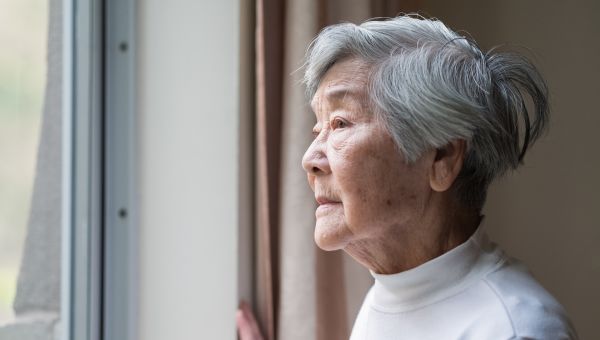Most women die from these 10 health issues
Learn how to lower your risk of the deadliest conditions for U.S. women.
Updated on January 7, 2025

Did you know that several of the top causes of death may be preventable, according to the Centers for Disease Control and Prevention (CDC)? Adopting healthy lifestyle habits can help lower the risk of many life-threatening medical conditions. It can also help you remain active and energetic as you grow older.
With that in mind, here are the leading causes of death for women in the United States, plus key tips on how to stay well.

#1 Heart disease
Heart disease has long been the number one killer of both men and women in the U.S. It affects people of all ages and for women, is responsible for about one in five deaths each year. In fact, nearly half of all women in the U.S. have some type of heart disease.
Heart disease can take a number of forms, including:
- Coronary artery disease, when artery walls become thick and blocked
- Arrhythmia, when the heart beats in an irregular way—too slowly or too quickly
- Heart failure, when the heart isn’t strong enough to properly pump blood
Women are also less likely to survive heart attacks than men. This includes women under age 55, who are about twice as likely to die of an in-hospital heart attack as men their age.
To improve your likelihood of survival, learn to recognize the symptoms of a heart attack, which can include pressure in the chest, pain in the arm, back, or shoulder, shortness of breath, nausea or vomiting, anxiety, or unusual fatigue or weakness.
You may be at especially high risk if you smoke, have high blood pressure, high blood cholesterol, high blood sugar, obesity, or stress. To lower your chances of developing a heart condition, quit smoking and practice heart-healthy habits at every age.

#2 Cancer
Thanks to breakthroughs in screenings and treatments—as well as far less smoking—cancer death rates have steadily decreased in the U.S. for several decades. Yet, cancer remains the second most common cause of death for women. And though breast cancer is responsible for the deaths of more than 42,000 women each year, lung cancer is the top cancer killer of women, leading to more than 63,000 deaths annually.
About 50 percent of all cancer deaths may be preventable. If you smoke, it’s important to quit. It’s the biggest risk factor of them all, contributing to about 30 percent of cancer deaths. To lower your overall risk, also take steps to maintain a healthy weight, follow a healthy diet, exercise regularly, and avoid or limit alcohol.

#3 Stroke
About one in five women between ages 55 and 75 will have a stroke, and more than half of stroke deaths are women.
It’s crucial to get medical help at the first sign of a stroke. Look for the following symptoms and call 911 right away if you experience any of them:
- Numbness or weakness in your arms, legs, or face
- Difficulty speaking or understanding speech
- Sudden confusion or dizziness
- Blurred vision
- A spontaneous, severe headache
Women may have additional symptoms, as well, such as general weakness (rather than weakness on just one side of the body), brain fog, nausea, and vomiting.
Many strokes may be preventable by taking steps such as eating a heart-healthy diet, getting regular exercise, practicing stress-management strategies, and keeping on top of risk factors such as high blood pressure, high cholesterol, obesity, and sleep apnea.

#4 COVID-19
Although the COVID pandemic has ebbed thanks to the widespread availability of vaccines, the disease remains lethal for many people. An estimated 186,552 people died of COVID in the U.S. in 2022, the most recent year for which the CDC has confirmed numbers. About 5.4 percent of women's deaths were caused by the disease.
It should be noted, however, that provisional (preliminary) 2024 data from the CDC show that COVID deaths have dropped drastically since 2022. Given this trend, it may no longer be a top 10 cause of death in coming years.
In the meantime, to help prevent a COVID infection, it’s important to stay up to date with your vaccinations, practice good hygiene, and make sure indoor spaces are well-ventilated and filtered for cleaner air.

#5 Alzheimer’s disease
Nearly 7 million Americans live with Alzheimer’s disease (AD), and almost two-thirds of them are women. As the population ages, those numbers will increase.
While scientists are looking for ways to both prevent and treat the degenerative and ultimately deadly brain disease, currently there is no cure. But research suggests that certain lifestyle changes might help lower your risk, or at least may push the onset of symptoms several years down the road. These include:
- Managing your blood pressure: Research has shown that memory and cognition suffer when blood pressure is high. Your healthcare provider (HCP) can offer recommendations to help keep it under control.
- Going for daily walks: Exercise seems to be a key factor in better cognitive function for older adults, and even those who have Alzheimer’s already have a slower rate of decline when they’re more active. Bring a friend or your dog along for the stroll—social interaction and affection can also help keep your brain sharp.
- Staying on top of hearing loss: Research suggests that people with uncorrected hearing loss are at a higher risk of Alzheimer’s disease. Using hearing aids may help slow cognitive decline.
- Keeping your mind active in retirement: Consider joining a book club or taking language classes. Cognitively stimulating activities may help maintain a healthy brain, according to some research.
Alzheimer’s also affects other members of the family. Women are more likely to provide unpaid, around-the-clock care for someone living with AD. Caregiving can be lonely, interfere with your job, and take a serious toll on your health. If you’re a caregiver, know the signs of caregiver burnout and look into getting help when you need it.

#6 Chronic lower respiratory diseases
Smoking is the number one risk factor for chronic lower respiratory diseases, including asthma and chronic obstructive pulmonary disease (COPD), which includes both emphysema and chronic bronchitis. More than twice as many women are diagnosed with bronchitis as men, and more women die from COPD than men each year.
Quitting smoking will greatly lower your risk of these respiratory illnesses, as well as many other chronic diseases. Ask your HCP about options that can help you quit. Your HCP can refer you to smoking cessation programs that can increase your chances of success.
Air pollution also plays a role. It’s important to avoid indoor pollutants, since most people spend most of their time indoors. This means limiting exposure to chemicals, secondhand smoke, mold, and radon.

#7 Unintentional injuries
Unintentional injuries is a catchall category that includes falls, car crashes, and crucially, drug overdoses. In 2022, nearly 108,000 people died by overdose, mostly involving opioids. Although men are more likely to overdose, women are affected in high numbers. If you or someone you love has a drug problem, reach out to an HCP for help or contact the Substance Abuse and Mental Health Services Administration's (SAMHSA) National Helpline at 1-800-662-HELP (4357).
Though other deaths in this category are referred to as “accidents,” some can be prevented by taking certain safety precautions. For example, most motor vehicle deaths involve passengers not wearing seatbelts. Buckle up even if you’re just going for a drive around the neighborhood.
Distracted driving also contributes to about nine deaths per day in the U.S. When you drive, avoid any type of distraction that involves taking your hands off the wheel, your eyes off the road, or your mind off driving. This includes texting, talking on a phone, using a screen map system, and eating.

#8 Diabetes
Diabetes is a chronic condition in which the body can’t produce or use enough insulin to control blood sugar. It can cause deadly complications, including kidney damage. People with diabetes often have other health conditions, such as heart disease, and some of the other deadly illnesses on this list may also be connected to diabetes.
In 2022, more than 101,000 deaths were directly caused by diabetes, according to the CDC. It was also a contributing factor in hundreds of thousands of other deaths.
Women are at increased risk of diabetes when they experience hormone changes related to pregnancy and menopause. Make sure to check in with your HCP regularly if you fall into either of these categories. Your HCP may recommend routine blood tests to monitor your blood sugar levels. Lifestyle changes such as adding more physical activity to your routine and eating a healthy, plant-forward diet can also reduce your risk of developing diabetes.

#9 Kidney disease
The kidneys are bean-shaped organs do the critical job of filtering blood, as well as collecting waste and toxins, which are then removed via your urine.
With chronic kidney disease (CKD), the kidneys gradually lose their ability to do their job. That can lead to blood pressure spikes, potentially deadly abnormal heart rhythms, and fluid build-up in the lungs, among other complications. Some people eventually develop irreversible kidney damage. In that case, a dialysis machine becomes necessary to take over the work of filtering toxins from the blood.
You can lower your risk of kidney disease by managing your blood pressure and diabetes, staying physically active, reaching and maintaining a healthy weight, and quitting smoking.

#10 Hypertension
Hypertension, or high blood pressure, affects almost half of women in the U.S. It occurs when blood pushes against blood vessel walls too hard. While having the condition increases the risk of several other potentially fatal illnesses—including heart disease, stroke, and diabetes—the CDC classifies high blood pressure itself as a separate cause of death.
The most common kind of high blood pressure is called primary (formerly essential) hypertension. It’s often linked to obesity, family history, aging, and not getting enough physical activity, among other factors. You can reduce your risk by adopting a healthy lifestyle, keeping track of your blood pressure numbers, and in many cases, taking medications as prescribed by an HCP.

Centers for Disease Control and Prevention/National Vital Statistics Reports. Deaths: Leading Causes for 2022. December 9, 2024.
Centers for Disease Control and Prevention. About Women and Heart Disease. Page last reviewed May 15, 2024.
National Institutes of Health. Sex disparities after heart attack. May 9, 2023.
National Heart, Lung, and Blood Institute. Heart Attacks in Women. Page last updated March 24, 2022.
National Cancer Institute: Surveillance, Epidemiology, and End Results Program. Cancer Stat Facts: Common Cancer Sites. Page accessed November 21, 2024.
American Cancer Society. Key Statistics for Breast Cancer. Page last updated January 17, 2024.
American Cancer Society. New Study Finds 40-Percent of Cancer Cases and Almost Half of all Deaths in the U.S. Linked to Modifiable Risk Factors. July 11, 2024.
Office on Women’s Health. Disparities and the Leading Causes of Death in Women - National Women's Health Week 2023. Page last updated May 15, 2023.
American Heart Association: Go Red for Women. Facts, Causes and Risks of Stroke. Page last reviewed February 16, 2024.
American Heart Association. Is it fatigue – or a stroke? Women shouldn't ignore these warning signs. May 31, 2019.
American Stroke Association. Risk Factors Under Your Control. Page accessed November 21, 2024.
American Lung Association. Steps to help protect against COVID-19. Page last updated September 4, 2024.
Alzheimer’s Association. Alzheimer's Disease Facts and Figures. Page accessed November 21, 2024.
National Institute on Aging. Preventing Alzheimer's Disease: What Do We Know? Page last reviewed October 10, 2023.
Alzheimer’s Association. Caregiver Stress. Page accessed November 21, 2024.
Alzheimer’s Association - Alzheimer’s Impact Movement. Factsheet: Women and Alzheimer’s Disease. March 2024.
American Lung Association. Protecting Your Lungs. Page last updated November 20, 2024.
Centers for Disease Control and Prevention. Accidents or Unintentional Injuries. Page last reviewed July 26, 2024.
USA.gov. Find help for substance abuse. December 2, 2024.
Centers for Disease Control and Prevention. Facts About Seat Belt Use. Page last updated April 24, 2024.
Centers for Disease Control and Prevention. Distracted Driving. Page last updated May 16, 2024.
American Diabetes Association. Statistics About Diabetes. Page accessed November 21, 2024.
Office on Women’s Health. Diabetes. Page last updated May 31, 2022.
National Institute of Diabetes and Digestive and Kidney Diseases. Your Kidneys and How They Work. Page last reviewed June 2018.
Centers for Disease Control and Prevention. Chronic Kidney Disease Basics. Page last updated May 15, 2024.
MillionHearts. Estimated Hypertension Prevalence, Treatment, and Control Among U.S. Adults. May 12, 2023.
Centers for Disease Control and Prevention. High Blood Pressure: High Blood Pressure Facts. May 15, 2024.
Cleveland Clinic. Primary Hypertension (Formerly Known as Essential Hypertension). October 26, 2021.
More On


video

article

slideshow


video


video
